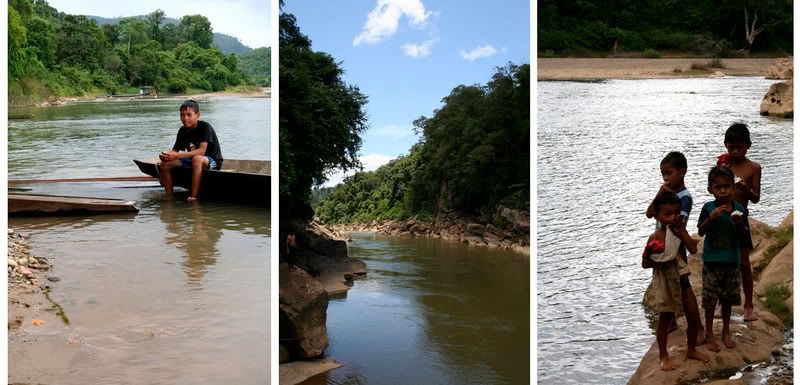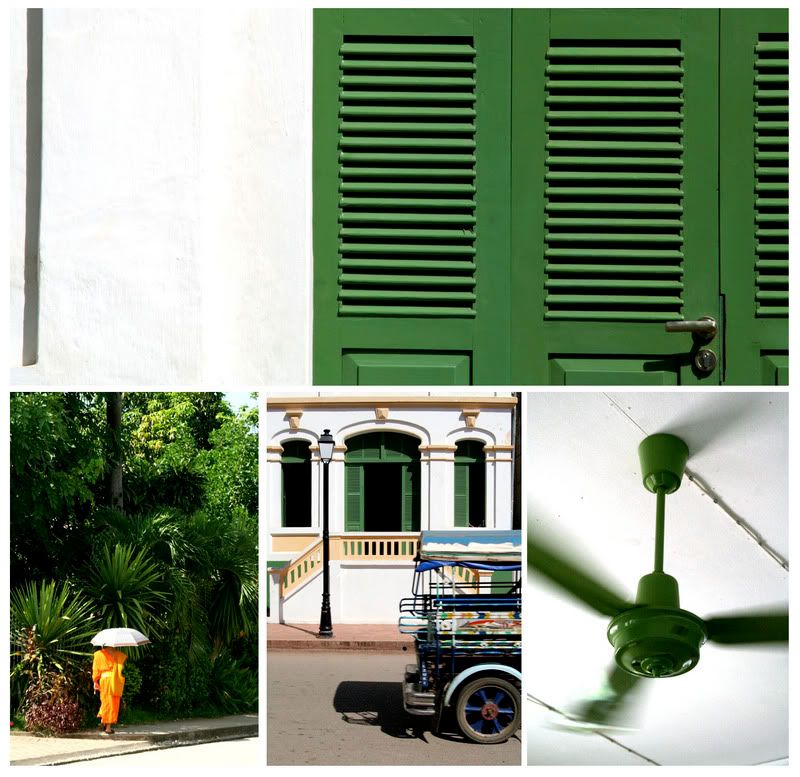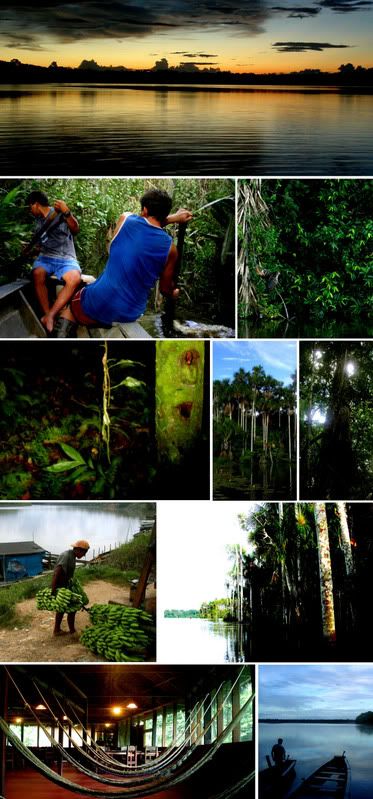
Unlike Thai food, which, thanks to Los Angeles' many fine Thai restaurants, I was familiar with, Lao food was completely unknown to me before my visit. Though some dishes in Laos were similar to food I'd had in Thailand, there were some notable differences. Lao food in general tends to be less spicy, and most subtly nuanced, with flavors balancing each other out.

One of the most noted legacies of the French occupation of Laos is the presence of the crusty baguettes sold just about everywhere. While the baguettes often come with meals at chic cafes and elegant restaurants, one of the best places to try them is at street-side stands. Foot long baguette sandwiches can be bought cheaply, and are surprisingly delicious. The bread is usually fresh, with a crisp crust and soft interior, and the sandwich is created with a seemingly strange mix of ingredients. Standard ingredients include cucumber, cold cuts, chili sauce, pate, and fish sauce (and for those who like it, dried pork flakes). The result is a sandwich that, like most Lao food, has a mix of nicely nuanced flavors and textures, with salty, spicy, and savory all delicately balanced.
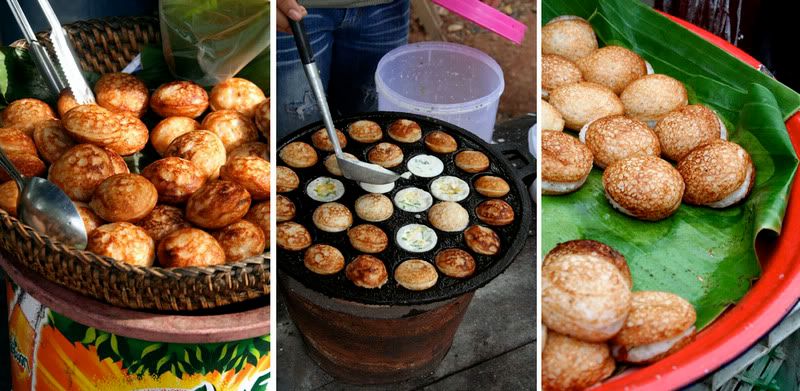
There were an amazing variety of snacks for sale at the morning markets, from fried crickets to while grilled chickens. One cheap street-food treat that I loved were the tiny rice-porridge tarts that were sold at markets all around Laos. I haven't been able to find out what they're called, and I can only guess what they're made of. They're poured as a batter into a sectional griddle, toasted brown, and served straight off the griddle. They're eaten piping hot, the creamy center able to burn the roof of your mouth. They usually have the flavor of a pancake, with hints of spring onion in the center. In southern Laos, I bought a batch that was made with sweet corn, and served with a coating of white sugar.

Considering that Laos is basically a long parcel of land stretch across the Mekong, it makes sense that a lot of food should come from the river. One of my favorite river treats was a Luang Prabang speciality called khai paen, fried river-weed chips. Bordeaux and I tried them at a cheap riverside restaurant in Luang Prabang, looking out over the Mekong. The riverweed was served in large, thin squares, and were so dark green as to be almost black. They had a soft seaweed taste, which was complimented by a coating of toasted sesame seeds. Perhaps best of all, the chips were served with jeowbong, a Luang Prabang chili paste. Though not particularly hot (the paste is made with 1/3 chili and 2/3 sugar), the paste added a sharp spicy-sweet flavor.

We happened to be in Laos during the season for river prawns, and we would often see the huge, blue prawns cooling in ice at foodstalls around Vientiane. Despite not really caring for prawns, I was curious to try one. I bought one in Vientienne, from what is likely Laos' least convincing transsexual (as Bordeaux said, Lao trannies just don't try very hard). The prawn was grilled over coals until it turned deep red, the shell just toasting black. It was tasty and surprisingly meaty, though as said, I don't really care for prawns. So what's the point of my review?

But by far, my favorite riverine meals was mok pa, a fish curry steamed in banana leaf. We ordered it at guesthouse in the 4000 Islands, in the tropical south of Laos. The fish is cooked in the banana leaf, turning it into a paste like consistency that is soft, delicate and full of flavor. It had a melting texture, and a strong, fresh lemon grass flavor, with sharp hints of kaffir-lime leaves.

One of the things I was most curious to try (but found most disappointing) was Lao coffee. Unlike the hilltribe flavor of Thailand, which was naturally sweet and highly flavorful, most of the Lao coffee I had was too dark and bitter for my taste. While this is certainly due in part to the quality of the coffee beans themselves, it was likely in part a result of the way the coffee is prepared. Lao coffee is generally prepared in in a metal sieve, and then served in a small glass over an inch of condensed milk. Though occasionally it came out well, the bitterness and sweetness nicely mixing, it often was simply too bitter, and too mudlike. Certain Western style coffeeshops, most notably JoMa in Vientiane and Luang Prabang, used Lao coffee to make delicious, if not uniquely flavorful, lattes and americanos. Morning Glory, in Luang Prabang, served a nice Lao coffee in a french press, fitting of its euro-tropical cafe.
 Having spent a beautiful but rough week in Southern Laos- no good coffee or muesli!- the Cambodian town of Kratie welcomed us with an array of simple but comforting Western pleasures. The dining highlight of Kratie was the cafe at the Star Guesthouse. It was situated in a corner spot, across from the food market. Over breakfast or lunch, we watched the goings-on at the fruit stands, and admired the bundles of green bananas that hawkers lugged by. The cafe had a wide range of coffees, good sandwiches using imported ingredients, and my staple breakfast, muesli and yogurt. Kratie itself was a pleasant town, with aged and faded French architecture, and a packed market selling fresh fish and colorful fruit. Just a few blocks away from the town center, and the neighborhoods become starkly more rural; bamboo and wooden stilt houses replaced concrete apartment blocks, and horse drawn carts plodded between moto traffic. The town also had a beautiful location along a wide stretch of the Mekong, which was best viewed from the promenade at sunset, as the golden light filtered through the colonnade of trees.
Having spent a beautiful but rough week in Southern Laos- no good coffee or muesli!- the Cambodian town of Kratie welcomed us with an array of simple but comforting Western pleasures. The dining highlight of Kratie was the cafe at the Star Guesthouse. It was situated in a corner spot, across from the food market. Over breakfast or lunch, we watched the goings-on at the fruit stands, and admired the bundles of green bananas that hawkers lugged by. The cafe had a wide range of coffees, good sandwiches using imported ingredients, and my staple breakfast, muesli and yogurt. Kratie itself was a pleasant town, with aged and faded French architecture, and a packed market selling fresh fish and colorful fruit. Just a few blocks away from the town center, and the neighborhoods become starkly more rural; bamboo and wooden stilt houses replaced concrete apartment blocks, and horse drawn carts plodded between moto traffic. The town also had a beautiful location along a wide stretch of the Mekong, which was best viewed from the promenade at sunset, as the golden light filtered through the colonnade of trees.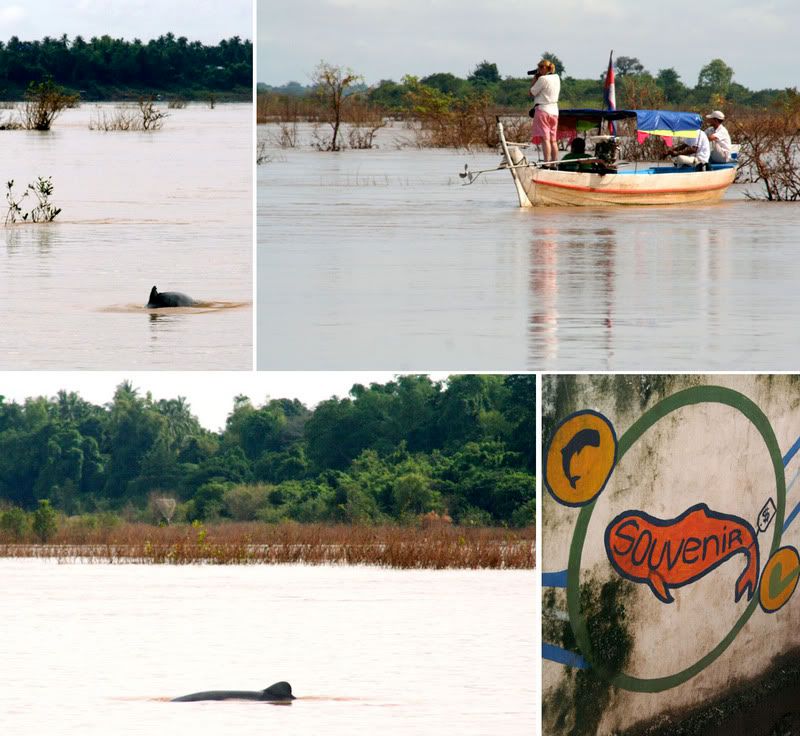 The dolphins are best seen from Kampie, a small town roughly 15 minutes moto ride from Kratie. The road out was easily one of the most interesting part of the trip. The were beautiful wood homes, with ornately carved accents on the roof and along the eaves; tiny bamboo houses, perched on stilts over muddy water; and all of this piled along the road against a backdrop of intensely green rice paddies. As the moto slowed down, I easily spotted the entrance to the dolphin site; there was a tacky dolphin statue, fading in the tropical sun. We paid the entrance fee, which had risen to about $7 US (well worth it, especially if it actually goes toward protecting the dolphins' habitat)- that included a boat trip with local guides, who were required not to use motors or to chase the dolphins.
The dolphins are best seen from Kampie, a small town roughly 15 minutes moto ride from Kratie. The road out was easily one of the most interesting part of the trip. The were beautiful wood homes, with ornately carved accents on the roof and along the eaves; tiny bamboo houses, perched on stilts over muddy water; and all of this piled along the road against a backdrop of intensely green rice paddies. As the moto slowed down, I easily spotted the entrance to the dolphin site; there was a tacky dolphin statue, fading in the tropical sun. We paid the entrance fee, which had risen to about $7 US (well worth it, especially if it actually goes toward protecting the dolphins' habitat)- that included a boat trip with local guides, who were required not to use motors or to chase the dolphins. From the dock, it was a ten minute boat trip out to the deeper pools that the dolphins favor. I had been worried that we wouldn't see any dolphins- perhaps still thinking of my elephant-less visit to the elephant tower at Ban Na- so I was very surprised how quickly we saw the first dolphin. It's silver fin sliced out of the water, and it disappeared again. I was confused by the fact that the boat driver didn't stop, and didn't seem to pay it any attention- but when we got to our destination, I saw why. We anchored the boat, and watched the water. The dolphins were everywhere. They would appear in pairs, the two fins usually rising in unison. They aren't as playful or as outgoing as their bottlenose relatives, but they still came fairly close to the boat. Occasionally they would show themselves long enough for me to see their distinctive blunt noses and bulbous heads. We watched them for an hour, during which time I tried unsuccessfully to get a good photo. Thankfully, the experience of seeing these strange and rare river creatures more than made up for that.
From the dock, it was a ten minute boat trip out to the deeper pools that the dolphins favor. I had been worried that we wouldn't see any dolphins- perhaps still thinking of my elephant-less visit to the elephant tower at Ban Na- so I was very surprised how quickly we saw the first dolphin. It's silver fin sliced out of the water, and it disappeared again. I was confused by the fact that the boat driver didn't stop, and didn't seem to pay it any attention- but when we got to our destination, I saw why. We anchored the boat, and watched the water. The dolphins were everywhere. They would appear in pairs, the two fins usually rising in unison. They aren't as playful or as outgoing as their bottlenose relatives, but they still came fairly close to the boat. Occasionally they would show themselves long enough for me to see their distinctive blunt noses and bulbous heads. We watched them for an hour, during which time I tried unsuccessfully to get a good photo. Thankfully, the experience of seeing these strange and rare river creatures more than made up for that.

























